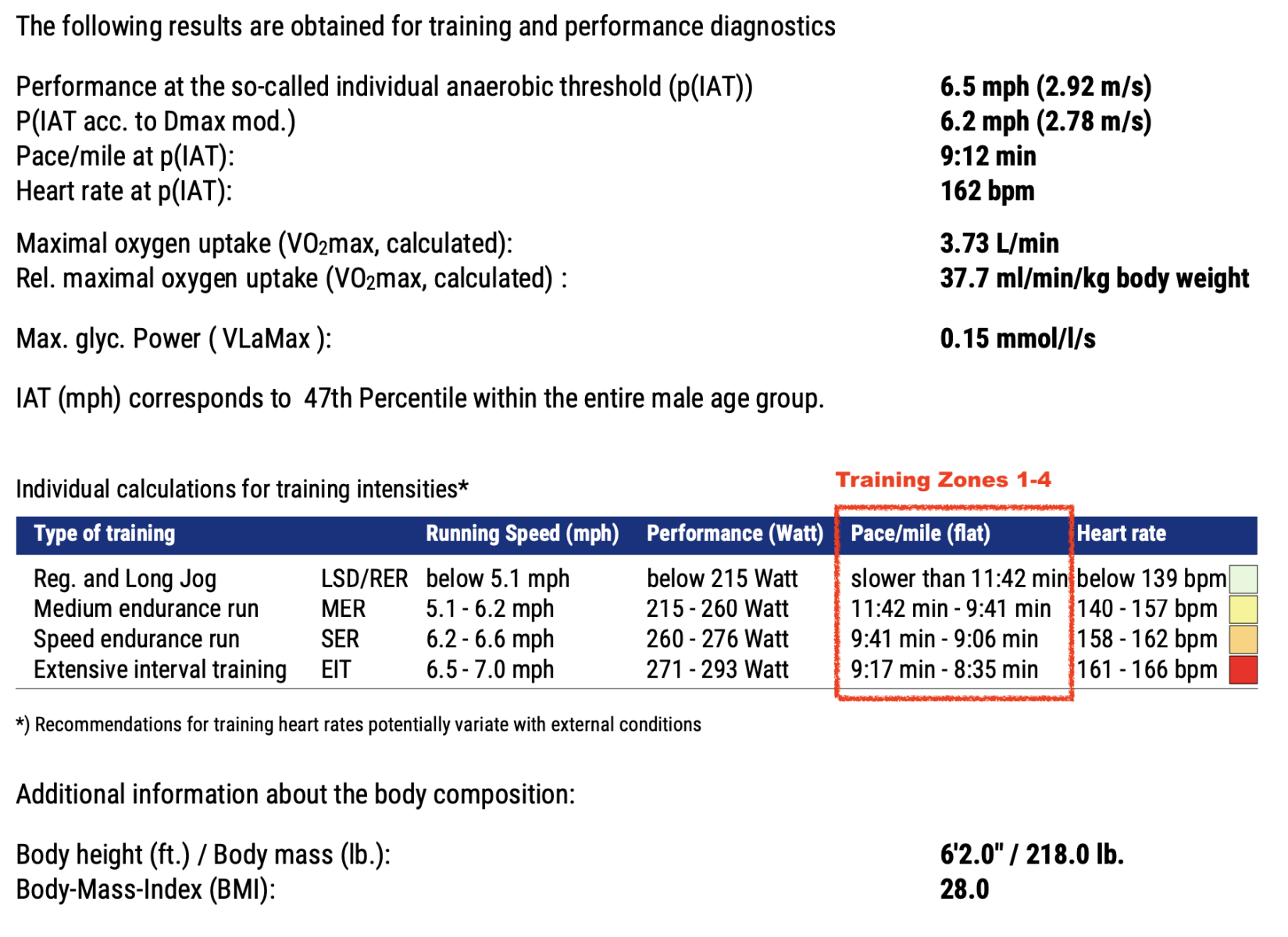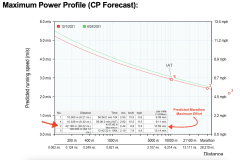Three weeks after completing Ironman Florida, I was scheduled to have cycling and running assessments. I assumed that my body would be suitably recovered and that I’d be fit enough to show at least modest improvements. Overall, I was feeling strong and accomplished from recently completing a tough Ironman event.
To execute the run assessment in a fasted state, I schedule them early in the morning. To ensure adequate glycogen reserves, I typically carbo-load for 2-3 days beforehand. In the past, I almost never did them properly fueled, and ended up bonking during the higher intensity portions of the assessment. Unfortunately, it happened again today. I reverted to my old habits and neglected my nutrition going into this test.
Doing the test
Going into the test, I felt very good. My body was rested, and strong, but my pelvic floor muscles were not feeling 100%. I don’t know why, but I could feel the difference and was a bit concerned. I even considered rescheduling the test but decided to see what I could do in my current state. Having recently faced some of the same physical limits at Ironman Florida, I decided that I should not develop the habit of backing off just because my body is performing sub-optimally. I really don’t know how long the pelvic floor recovery will take, so taking advantage of each day and doing as much as I can seem to be the best approach.
Since I do 99% of my training runs outside, running on a treadmill feels odd. The paces feel very different. For example, when I’m running on a trail, 9 min/mile doesn’t feel very fast or difficult. However, 9 min/mile on a treadmill feels very fast. I’m not sure why I perceive the speeds and efforts so differently but it affects my mindset. To prevent getting mentally distracted, I turn off the pace screen so that I never know how fast I’m running. A while back, I noticed that even if I was feeling comfortable at a pace of 8:15 min/mile, my mind would begin a negative spiral an begin spewing bullshit causing me to begin doubting my ability. In the end, I’d stop because my confidence would have disappeared and I’d refuse to push harder. The mental game is very real.
During a 20-minute warm-up, I needed to use the bathroom three times, so I told Johnny that I was experiencing some bladder weakness and wasn’t trying to hold it too long because I may experience some leakage. I didn’t want to pee on his treadmill. He said to just do the best that I could. If I could make it to the end without stopping, then great. If not, we’ll get what data that we can and move forward from there.
After warming up, I proceeded to do the test with the hope that I’d be able to push myself a little further than the previous assessment. However, in reality, my mind was occupied with those pesky malfunctioning pelvic floor muscles and any sign of an urge to urinate.
I tried to distract myself by envisioning that I was running on a trail in Colorado next to the professional triathlete Lionel Sanders. I visualized pushing myself hard while running through the trail next to him. This worked for what felt like 30 seconds at a time, then I’d return focus to my bladder and the anxiety about having to pee before getting through the test. I became discouraged halfway into the effort. I was not in a good place mentally.
While running at what felt like a mid to low 8 min/mile pace, my bladder began feeling full again. I had to decide if I could go for another 3-5 min or If I should stop at the end of the current segment. I was getting very close to my maximum RPE (relative perceived effort) and decided that I wasn’t in a place to be mentally strong, so I stopped the test. I felt disappointed but glad that I showed up anyway. I reminded myself that you improve what you measure.
Test Results
The results are below. They show that I’ve lost some fitness and that I was under-fueled. I was very disappointed and felt like I was starting from the beginning again.
The chart above shows the main results.- Individual Anaerobic Threshold (IAT) aka Maximum Lactate Steady State. Simply, this is when I begin running on borrowed time. Meaning, any effort above this one will result in blood lactate accumulating faster than my body can clear it. The performance of my muscles will begin to deteriorate until I reduce my effort and allow the blood lactate to be cleared. So, one of the main goals in training is to increase this measure which will allow me to race harder/faster for longer before I begin to experience degradation due to lactate accumulation.
- My running pace where I hit the IAT, 9:12 min/mile – faster is better.
- My heart rate at my IAT was 162 beats per minute. Lower is better.
- My training zones result from these parameters.
- Zone 1: slower than 11:42 min/mile
- Zone 2: 11:42 – 9:41 min/mile
- Zone 3: 9:41 – 9:06 min/mil
- Zone 4: 9:17 – 8:35 min/mile
- These training zones are adjusted after each performance test. My goal is to have faster zones (improved fitness) each time. The reality has been far from having that type of progression. Many aspects of life impact how well I train between each test. Never has it been ideal, so I haven’t achieved my ideal fitness progression.
- Since I don’t sign up and run short races for fun, the relevant forecasts for me are the half and full marathon distances. The caveat here is that these forecasts are for stand-alone events, not a triathlon. My predicted maximum effort marathon time is 4hr 47 min, by sustaining a 10:59 min/mile pace. I believe this is accurate.
- The parameters that I find important in the comparison table are highlighted with colored boxes.
- Lactate threshold – The point at which blood lactate begins to rapidly accumulate. This remained unchanged. I always want this to increase, reflecting improved fitness.
- Heart rate at lactate threshold
- Individual Anaerobic Threshold (IAT) – This declined a little. My goal is to see improvements over time.
- The predicted half marathon and full marathon times decreased reflecting a loss in my fitness since August.
Looking forward
Test results that are below expectations are part of the journey. Running is my most challenging discipline and its development has been on the back burner. After the test, Johnny and I discussed a plan going forward. Now that the race season is over, I am going to focus on losing weight and getting lean. My current weight is 218 Lbs, he would like me to get into the low 190s. I’m uncomfortable with going that low, I think that I’ll start to look crackhead-like, so I’ll shoot for 200 Lbs and see how I look and feel. If all is well, I’ll move in the 190s. To accomplish the rapid weight loss, I’ll do 18-6 intermittent fasting, and avoid high-intensity training sessions. One of my weekly cycling workouts will be substituted with an additional running session. All will be 1hr to 1.5 hrs 90% zone 1. In February, I’ll shift back into power and performance mode and Ironman Race building sessions. The decrease in weight, focus on form and cadence, and some strength work should yield a better running performance on race day.
Next races are: Ironman 70.3 Galveston on April 3, 2022, and Ironman Texas on April 23, 2022. I’m preparing for a strong season 💪🏾.









You’re over extended.
Give yourself time to recover.
First Half Ironman, 1982.
Not a typo.
Yep, I think I missed the part where I should have given my mind and body real rest and recovery time. 1982? Are you still racing triathlons?